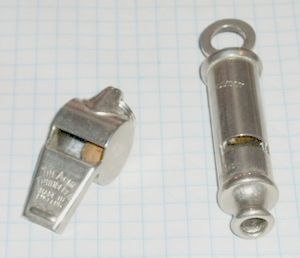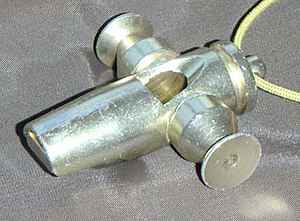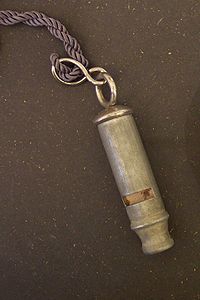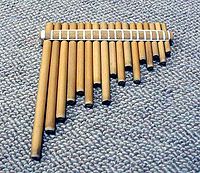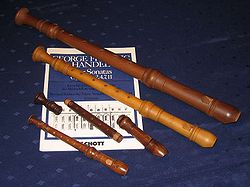Difference between revisions of "AY Honors/Whistles/Answer Key"
| Line 2: | Line 2: | ||
==1. Relate briefly the history of whistle making and tell why whistles were invented.== | ==1. Relate briefly the history of whistle making and tell why whistles were invented.== | ||
| + | The whistle has its roots dating back to ancient China, where night watchmen would blow into the tops of acorns to alert the towns to invading Mongolians. In ancient Egypt two blades of the papyrus plant along the Nile river were held together in between the palms. By blowing into the palms the papyrus leaves would make a loud vibrant sound. | ||
| − | [ | + | === Police whistles === |
| + | [[Image:Police whistles.jpg|thumb|Examples of police whistles]] | ||
| − | + | In England since the Metropolitan Police Services inception in 1829, officers have been issued with the "Metropolitan" whistle. Prior to this, police used hand rattles, with whistles only being used as musical instruments or toys. Both rattles and whistles were used to call for back-up in areas where neighbourhood beats overlapped, and following their success in London, the whistle was adopted by most counties in England. | |
| − | + | Police whistles fell into disuse in many countries in 1969, when early hand-held radios were brought into service. With the rise of the motor car, the whistle was no longer usefully audible in urban areas. The whistle is still used by some police forces today, and engraved ceremonial versions are sometimes presented to police officers upon occasions such as their retirement. | |
| − | + | === Industrial whistles === | |
| − | [http:// | + | Industrial whistles are used for signalling and timekeeping both on railroad and ships, and in factories. Most of these whistles were steam powered and not standardized. Individual locomotives could be identified by their whistles. At noontime in industrial areas up into the 1950s whistles of every pitch could be heard, as each factory had a boiler and a whistle, if not full steam power. |
| + | |||
| + | === Safety === | ||
| + | |||
| + | Whistles are often used as warning devices or as safety devices serving to attract attention to the user. Some cyclists use a whistle as a substitute for a bell or horn. It should be noted, however, that many jurisdictions require that the warning device be permanently attached to the bicycle. | ||
| + | |||
| + | Rescue or survival whistles are often packed in survival kits and attached to personal flotation devices to allow a victim to signal for help. The whistle is audible at much greater distances than the human voice, and is less likely to cause exhaustion if used repeatedly. Survival whistles differ from pea whistles in that they are usually flat, so that water cannot collect inside if the user is immersed, for example after falling overboard from a boat. | ||
| + | |||
| + | Whistles can also produce sounds at pitches inaudible to the human ear such as dog whistles which can be heard by dogs at a range beyond that of human sensory perception, or at least conscious perception. | ||
| + | |||
| + | === Boats === | ||
| + | |||
| + | Ship's whistles must be very loud for safety on the seas. Modern ship's whistles can be electrically or steam driven. The RMS Queen Mary was originally equipped with three electric ''Tyfon'' whistles in 1932. They could be heard at least ten miles away and were tuned to 55 Hz, a low bass ''A'' note that was chosen for maximum passenger comfort despite the high sound pressure level. One of the three whistles was taken back to Kockum Sonics in Malmö, Sweden, where it was refurbished for a new life of service aboard the RMS ''Queen Mary 2''. Modern IMO regulations specify ships' whistle frequencies to be in the range 70-200 Hz for vessels that are over 200 meters in length.<ref>[http://www.kockumsonics.com/products/marine/marine_tyfon_imo_regulations.htm Kockum Sonics: Tyfon product IMO regulations]</ref> Traditionally, the lower the frequency, the larger the ship. The ''Queen Mary 2'', being 345 meters long, was given the lowest possible frequency (70 Hz) for her regulation whistles which means she carries both 70 Hz modern whistles and a single vintage 55 Hz whistle. | ||
| + | |||
| + | === Trains === | ||
| + | |||
| + | Railroads in particular used elaborate whistle codes for communication both within the train and with other trains. These methods are maintained today with motor-powered air horns. Trucks also use air horns, especially since they often have air brakes and so there is already a source of compressed air on board. | ||
| + | |||
| + | Train whistles generally produce three or four different frequencies at the same time to produce a non-major chord that is distinct, loud, and low in pitch. | ||
| + | |||
| + | === Sporting === | ||
| + | |||
| + | Whistles are used by referees to officiate sporting matches. The whistle was first used to stop a sports match by William Atack in an 1884 game of rugby in New Zealand. Before that game referees used their voices to control play. | ||
| + | |||
| + | Some sports use different types of whistles, but one used around the world in many sports is the Fox 40, a pealess whistle which creates sound using air pressure only. The Fox 40 is used in basketball, hockey, ice hockey, soccer and numerous other games, as it can be heard easily over the noise of the audience. | ||
| + | |||
| + | Another whistle widely used for sports such as Touch Football, Rugby League and Rugby Union is the Thunderer 58.5 by Acme Whistles. It is a metal whistle containing a cork pea. It is used mainly because of its design that allows the user to create a deep, low-pitch shrill that can be heard from hundreds of meters away. | ||
| + | |||
| + | === Music === | ||
| + | |||
| + | [[Image:SambaWhistle.jpg|thumb|A samba whistle with three tones]] | ||
| + | The whistle is used by a leader in samba percussion groups help to catch the percussionist's attention. The traditional samba whistle has three tones, but as the size of the percussion section rose, pealess whistles became more popular due to their high pitch and their loud sound. | ||
| + | |||
| + | The slide Whistle (or swanee whistle) was a common instrument in some types of music and was popular as a musical effect in the early days of radio and television. | ||
| + | |||
| + | Pitch pipes are reed whistles used to help in tuning musical instruments and have been common since the 1850s. | ||
| + | |||
| + | === Military === | ||
| + | |||
| + | Whistles were used in various military engagements in the 20th century. They were used primarily to initiate a pre-set plan so that all parts (within earshot) would move simultaneously. For example, officers in the World War I would sometimes blow whistles to signal all troops along a broad stretch of trench to attack at the same time. | ||
| + | |||
| + | === Others === | ||
| + | |||
| + | Other whistles include bird calls, game calls, shepherd's whistles, Swiss warblers, Chinese pigeon whistles, Chinese and Japanese kite whistles, cuckoo clocks whistles, communication tube whistles, whistling kettles, whistling tops and various toy whistles. | ||
| + | |||
| + | === Patents and inventors === | ||
| + | |||
| + | In 1868 Joseph Hudson of Birmingham], England, made the first whistle ever to be used by a football referee. New Zealand referee William Atack was the world's first to use a whistle to stop a game of sport in 1884. It was used for the first time (allegedly) at a game held at Nottingham Forest, prior to this referees used handkerchiefs to attract players' attention. | ||
| + | |||
| + | By 1884, Joseph Hudson had perfected his whistles and he released the world's most successful whistle to date, the "Acme Thunderer" (the first ever pea whistle). The whistle has been used as an alarm or attention-getting instrument by all manner of industries, sports and revellers. It continues to sell in great quantities throughout the world. | ||
==2. Explain the importance of conservation in regard to whistle making.== | ==2. Explain the importance of conservation in regard to whistle making.== | ||
Revision as of 03:36, 18 December 2009
1. Relate briefly the history of whistle making and tell why whistles were invented.
The whistle has its roots dating back to ancient China, where night watchmen would blow into the tops of acorns to alert the towns to invading Mongolians. In ancient Egypt two blades of the papyrus plant along the Nile river were held together in between the palms. By blowing into the palms the papyrus leaves would make a loud vibrant sound.
Police whistles
In England since the Metropolitan Police Services inception in 1829, officers have been issued with the "Metropolitan" whistle. Prior to this, police used hand rattles, with whistles only being used as musical instruments or toys. Both rattles and whistles were used to call for back-up in areas where neighbourhood beats overlapped, and following their success in London, the whistle was adopted by most counties in England.
Police whistles fell into disuse in many countries in 1969, when early hand-held radios were brought into service. With the rise of the motor car, the whistle was no longer usefully audible in urban areas. The whistle is still used by some police forces today, and engraved ceremonial versions are sometimes presented to police officers upon occasions such as their retirement.
Industrial whistles
Industrial whistles are used for signalling and timekeeping both on railroad and ships, and in factories. Most of these whistles were steam powered and not standardized. Individual locomotives could be identified by their whistles. At noontime in industrial areas up into the 1950s whistles of every pitch could be heard, as each factory had a boiler and a whistle, if not full steam power.
Safety
Whistles are often used as warning devices or as safety devices serving to attract attention to the user. Some cyclists use a whistle as a substitute for a bell or horn. It should be noted, however, that many jurisdictions require that the warning device be permanently attached to the bicycle.
Rescue or survival whistles are often packed in survival kits and attached to personal flotation devices to allow a victim to signal for help. The whistle is audible at much greater distances than the human voice, and is less likely to cause exhaustion if used repeatedly. Survival whistles differ from pea whistles in that they are usually flat, so that water cannot collect inside if the user is immersed, for example after falling overboard from a boat.
Whistles can also produce sounds at pitches inaudible to the human ear such as dog whistles which can be heard by dogs at a range beyond that of human sensory perception, or at least conscious perception.
Boats
Ship's whistles must be very loud for safety on the seas. Modern ship's whistles can be electrically or steam driven. The RMS Queen Mary was originally equipped with three electric Tyfon whistles in 1932. They could be heard at least ten miles away and were tuned to 55 Hz, a low bass A note that was chosen for maximum passenger comfort despite the high sound pressure level. One of the three whistles was taken back to Kockum Sonics in Malmö, Sweden, where it was refurbished for a new life of service aboard the RMS Queen Mary 2. Modern IMO regulations specify ships' whistle frequencies to be in the range 70-200 Hz for vessels that are over 200 meters in length.& Traditionally, the lower the frequency, the larger the ship. The Queen Mary 2, being 345 meters long, was given the lowest possible frequency (70 Hz) for her regulation whistles which means she carries both 70 Hz modern whistles and a single vintage 55 Hz whistle.
Trains
Railroads in particular used elaborate whistle codes for communication both within the train and with other trains. These methods are maintained today with motor-powered air horns. Trucks also use air horns, especially since they often have air brakes and so there is already a source of compressed air on board.
Train whistles generally produce three or four different frequencies at the same time to produce a non-major chord that is distinct, loud, and low in pitch.
Sporting
Whistles are used by referees to officiate sporting matches. The whistle was first used to stop a sports match by William Atack in an 1884 game of rugby in New Zealand. Before that game referees used their voices to control play.
Some sports use different types of whistles, but one used around the world in many sports is the Fox 40, a pealess whistle which creates sound using air pressure only. The Fox 40 is used in basketball, hockey, ice hockey, soccer and numerous other games, as it can be heard easily over the noise of the audience.
Another whistle widely used for sports such as Touch Football, Rugby League and Rugby Union is the Thunderer 58.5 by Acme Whistles. It is a metal whistle containing a cork pea. It is used mainly because of its design that allows the user to create a deep, low-pitch shrill that can be heard from hundreds of meters away.
Music
The whistle is used by a leader in samba percussion groups help to catch the percussionist's attention. The traditional samba whistle has three tones, but as the size of the percussion section rose, pealess whistles became more popular due to their high pitch and their loud sound.
The slide Whistle (or swanee whistle) was a common instrument in some types of music and was popular as a musical effect in the early days of radio and television.
Pitch pipes are reed whistles used to help in tuning musical instruments and have been common since the 1850s.
Military
Whistles were used in various military engagements in the 20th century. They were used primarily to initiate a pre-set plan so that all parts (within earshot) would move simultaneously. For example, officers in the World War I would sometimes blow whistles to signal all troops along a broad stretch of trench to attack at the same time.
Others
Other whistles include bird calls, game calls, shepherd's whistles, Swiss warblers, Chinese pigeon whistles, Chinese and Japanese kite whistles, cuckoo clocks whistles, communication tube whistles, whistling kettles, whistling tops and various toy whistles.
Patents and inventors
In 1868 Joseph Hudson of Birmingham], England, made the first whistle ever to be used by a football referee. New Zealand referee William Atack was the world's first to use a whistle to stop a game of sport in 1884. It was used for the first time (allegedly) at a game held at Nottingham Forest, prior to this referees used handkerchiefs to attract players' attention.
By 1884, Joseph Hudson had perfected his whistles and he released the world's most successful whistle to date, the "Acme Thunderer" (the first ever pea whistle). The whistle has been used as an alarm or attention-getting instrument by all manner of industries, sports and revellers. It continues to sell in great quantities throughout the world.
2. Explain the importance of conservation in regard to whistle making.
The Pathfinder motto of "Take nothing but pictures, leave nothing but footprints", is an important consideration, but obviously you cannot make a whistle without taking some wood. Consider your location carefully for harvesting a twig or two. Try searching for willow bushes in a county road ditch where road crews will have to clear the trees for the safety of drivers and harvest a few before the crews arrive. Maybe you know someone with a hedge that needs trimming ?
Avoid harvesting twigs in any areas sensitive to loss. If your harvesting would disturb nature, look for another location.
3. What do the seasons of the year have to do with making a willow whistle?
Sap is a liquid that circulates within the sapwood of trees. Sap rises up from the roots. Sap contains water and minerals; in the spring it also contains sugars and stimulates the growth of the tree.
A willow whistle requires the maker to remove the bark from a willow twig in a tube shaped piece. The best (or only) season that this can be done is in the spring when there is more sap rising up the tree. This makes the bark more removable from the twig.
4. Name two (2) trees that make the best whistles and why. List three (3) other trees that can be used to make whistles.
Willow and Maple trees are considered the best for making whistles. Willow is often more plentiful than maple, and they grow back very quickly when cut. Some prefer maple because it is straighter and has fewer knots. Maples also grow back quickly if cut from a large stump.
5. Give a brief description of the following styles of whistles:
a. Tube Whistles
b. Pan Whistles
c. Flute Whistles
6. Name five (5) types of modern whistles and their uses.
7. What modern musical instrument is a sophisticated whistle?
The recorder is a woodwind musical instrument of the family known as fipple flutes or internal duct flutes — whistle-like instruments which include the tin whistle and ocarina. The recorder is end-blown and the mouth of the instrument is constricted by a wooden plug, known as a block or fipple.
The recorder was popular from medieval times but declined in the 18th century in favour of orchestral woodwind instruments, such as the flute, oboe, and clarinet. During its heyday, the recorder was traditionally associated with birds, shepherds, miraculous events, funerals, marriages and amorous scenes. Images of recorders can be found in literature and artwork associated with all these. Purcell, Bach, Telemann and Vivaldi used the recorder to suggest shepherds and birds, and the pattern continued into the 20th century.
The recorder was revived in the 20th century, partly in the pursuit of historically informed performance of early music, but also because of its suitability as a simple instrument for teaching music and its appeal to amateur players. Today, it is often thought of as a child's instrument, but there are many excellent virtuosic players who can demonstrate the instrument's full potential as a solo instrument. The sound of the recorder is remarkably clear and sweet, partly because of the lack of upper harmonics and predominance of odd harmonics in the sound.
8. How does a whistle work?
9. What is the most common equipment used in making whistles?
10. Explain the importance of wood grain in whittling a whistle.
11. Why must the size of the holes and chamber be proportional to the amount of airflow?
12. How do you tune a whistle?
13. Demonstrate that you can make a two-handed whistle using your hand and a piece of grass.
14. Demonstrate the technique and try to accomplish a whistle using your hand(s) or fingers.
15. Review and demonstrate the proper first aid and safety rules for the usage of a pocketknife.
First Aid
Adventist Youth Honors Answer Book/First aid/Bleeding
AY Honor First Aid, Basic
Knife Safety
Adventist Youth Honors Answer Book/Camping/Knife safety
16. Know how to sharpen a pocketknife using a whetstone or oil sharpening stone.
A tool can be sharpened with a whetstone. Most whetstones need to be kept wet when they are in use - some are wet with water and others are wet with oil. Stones with finer grain typically use oil, but you can use water on them as well. The purpose of wetting a whetstone is to allow the steel removed from the blade to float away. The finer the stone, the finer the edge it will make on a tool, but the longer it will take to sharpen it. For this reason, a very dull tool should be sharpened first with a coarser stone, and then with a finer stone. Then it should be kept sharp. You can keep a blade sharp by respecting it - do not chop into the ground with a hatchet, and to not stick a knife blade in the ground either. Dirt is highly abrasive, and a rock will ding the edge very quickly. Close a pocket knife when you are finished using it, and do not allow the business end of a blade to touch anything other than the things you are trying to cut with it.
To sharpen a knife, hold the blade at about a 15° angle and scrape it along a whetstone as if you were trying to shave off a thin layer of the stone. Be sure to sharpen both sides.
